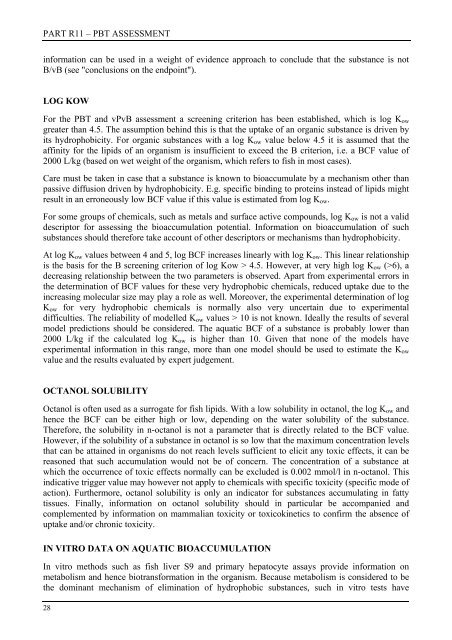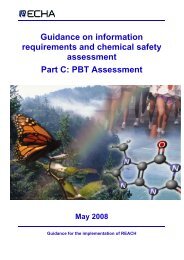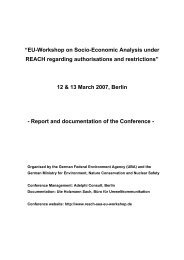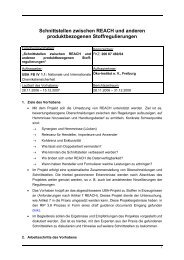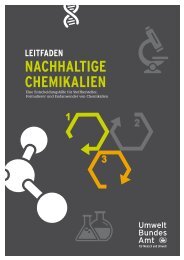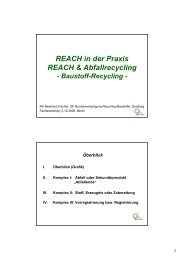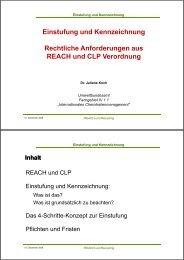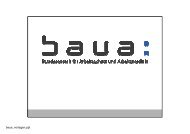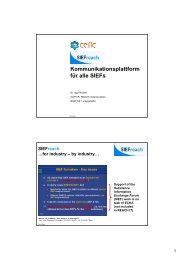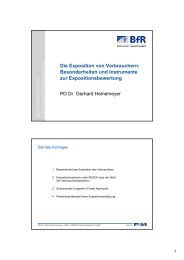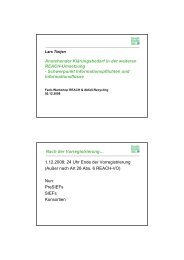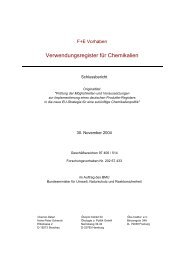PBT Assessment - REACh
PBT Assessment - REACh
PBT Assessment - REACh
You also want an ePaper? Increase the reach of your titles
YUMPU automatically turns print PDFs into web optimized ePapers that Google loves.
PART R11 – <strong>PBT</strong> ASSESSMENT<br />
information can be used in a weight of evidence approach to conclude that the substance is not<br />
B/vB (see "conclusions on the endpoint").<br />
LOG KOW<br />
For the <strong>PBT</strong> and vPvB assessment a screening criterion has been established, which is log Kow<br />
greater than 4.5. The assumption behind this is that the uptake of an organic substance is driven by<br />
its hydrophobicity. For organic substances with a log Kow value below 4.5 it is assumed that the<br />
affinity for the lipids of an organism is insufficient to exceed the B criterion, i.e. a BCF value of<br />
2000 L/kg (based on wet weight of the organism, which refers to fish in most cases).<br />
Care must be taken in case that a substance is known to bioaccumulate by a mechanism other than<br />
passive diffusion driven by hydrophobicity. E.g. specific binding to proteins instead of lipids might<br />
result in an erroneously low BCF value if this value is estimated from log Kow.<br />
For some groups of chemicals, such as metals and surface active compounds, log Kow is not a valid<br />
descriptor for assessing the bioaccumulation potential. Information on bioaccumulation of such<br />
substances should therefore take account of other descriptors or mechanisms than hydrophobicity.<br />
At log Kow values between 4 and 5, log BCF increases linearly with log Kow. This linear relationship<br />
is the basis for the B screening criterion of log Kow > 4.5. However, at very high log Kow (>6), a<br />
decreasing relationship between the two parameters is observed. Apart from experimental errors in<br />
the determination of BCF values for these very hydrophobic chemicals, reduced uptake due to the<br />
increasing molecular size may play a role as well. Moreover, the experimental determination of log<br />
Kow for very hydrophobic chemicals is normally also very uncertain due to experimental<br />
difficulties. The reliability of modelled Kow values > 10 is not known. Ideally the results of several<br />
model predictions should be considered. The aquatic BCF of a substance is probably lower than<br />
2000 L/kg if the calculated log Kow is higher than 10. Given that none of the models have<br />
experimental information in this range, more than one model should be used to estimate the Kow<br />
value and the results evaluated by expert judgement.<br />
OCTANOL SOLUBILITY<br />
Octanol is often used as a surrogate for fish lipids. With a low solubility in octanol, the log Kow and<br />
hence the BCF can be either high or low, depending on the water solubility of the substance.<br />
Therefore, the solubility in n-octanol is not a parameter that is directly related to the BCF value.<br />
However, if the solubility of a substance in octanol is so low that the maximum concentration levels<br />
that can be attained in organisms do not reach levels sufficient to elicit any toxic effects, it can be<br />
reasoned that such accumulation would not be of concern. The concentration of a substance at<br />
which the occurrence of toxic effects normally can be excluded is 0.002 mmol/l in n-octanol. This<br />
indicative trigger value may however not apply to chemicals with specific toxicity (specific mode of<br />
action). Furthermore, octanol solubility is only an indicator for substances accumulating in fatty<br />
tissues. Finally, information on octanol solubility should in particular be accompanied and<br />
complemented by information on mammalian toxicity or toxicokinetics to confirm the absence of<br />
uptake and/or chronic toxicity.<br />
IN VITRO DATA ON AQUATIC BIOACCUMULATION<br />
In vitro methods such as fish liver S9 and primary hepatocyte assays provide information on<br />
metabolism and hence biotransformation in the organism. Because metabolism is considered to be<br />
the dominant mechanism of elimination of hydrophobic substances, such in vitro tests have<br />
28


